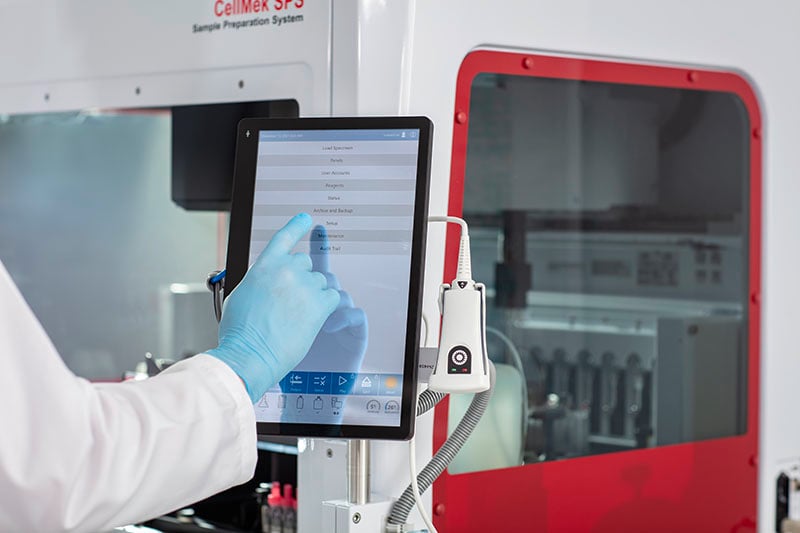CellMek SPS: Audit Trail Features

Table 1. Information available in the Audit Trail
| Category | Information |
|---|---|
| Panels & Worklist | |
| Panel added/removed to/from specimen | Panel Name, Specimen Barcode, LIS Order (Yes / No) |
| Worklist created | Worklist file successfully generated to (Network path / path on USB drive) |
| Consumables | |
| Liquid reagent vial | Reagent Name, Part Number, Regulatory status, Lot, Exp. Date, Remaining Volume |
| DURACartridge (Dry reagents) | Reagent Name, Part Number, Lot, Date of Manufacture, Exp. Date, Number of Tests, Number of Remaining Tests |
| Diluent reagent | Reagent Name, Part Number, Regulatory status, Lot, Exp. Date, Remaining Volume |
| External Resource | |
| Status on Condensate, Diluent, Waste | full / empty |
| Instrument Monitoring & Access | |
| Status on Liquid Antibody Module | opened / closed / open > 5 min |
| Liquid Antibody Module temperature is outside the range of 2°C to 8°C | Temperature in °C |
| Status on output carousel | Drawer opened / closed |
| Status on reaction plate module | Lid closed /opened |
| Maintenance / Service | |
| Shutdown | Instrument shutdown completed successfully |
| Maintenance Prime Clean Cell Wash | Prime and Clean Cell Wash procedure completed successfully / failed |
Click on the sections below and learn more about the intuitive software interface to retrieve the audit trail, sample and specimen reports.
-
From the CellMek SPS Home Screen, select the Audit Trail (Figure 1)
- Select the date of interest. Instrument will display actions taken with associated time stamps on the given date. These can also be filtered by Category and User to assist with searchability.
Examples:
Figure 2. Shutdown
*Noting the last occurrence of shutdown prior to testing start helps avoid disruption due to 24hr restart requirement.
Figure 3. User Activity, Startup, Reagent Information, Error, Panel Assignment
In addition to the examples above, the Audit Trail function on the CellMek SPS instrument touchscreen GUI will also show event categories such as (examples only, list is not comprehensive):
- Panel Import – shows information on panels imported into system from Panel Designer Software
- Password Changes
- Module activity (e.g. opening of liquid antibody module)
- User permissions
- Maintenance events (incl. daily Prime procedure)
- External resource error messages (e.g. waste tank full)
- Liquid antibody module Monitoring incl. temperature
Select Archive and Backup from the CellMek SPS Home Screen to export the audit trail (Figure 4)
Select the dates desired and check the box for Archive Audit Trail. Ensure a USB is inserted in the CellMek SPS. The system will write an Archive file to a folder named CellMek on the USB.
Figure 5. Archive and Backup menu of CellMek SPS
Records associated with archive dates will display in the Archive History.
Figure 6. Archive History
The archive files stored to the USB drive can now be imported into the Panel Designer software.
Figure 7. Open CellMek Panel Designer application on personal computer. Select Open Archive.
Select from the CellMek folder the archive file previously generated by the CellMek SPS. The file will open within the Panel Designer software, where the Audit Trail can be selected and filtered by date(s).
Example:
Figure 8. Audit Trail info open in Panel Designer Software.
Select Sample to obtain run information by Sample ID, which are auto-populated in the drop down when the cursor is placed in the field:
Figure 9. Selection of sample log by Sample ID
Figure 10. Example of information contained in sample log
The Sample log contains the following information:
Report Generated Time, Sample ID, Instrument Serial Number, Instrument Name, Software Version, Cassette Type and ID, Cassette Tube Location, Specimen ID, Cell Concentration Index and Source, Specimen Flags and Notifications, Panel Name and Version, Specimen Volume, Panel Flags and Notifications, Reaction Plate IDs and Well Locations, Reagent Names, Reagent Part and Lot Numbers, Reagent Vial IDs, Reagent Expiration Dates, Reagent Volume, Reagent QC Status, Consumables, User, and Comment.
In the same way, specimen logs can also be retrieved from the archived Audit Trail information:
Select Specimen to obtain run information by Specimen ID, which are auto-populated in the drop down when the cursor is placed in the field.
Figure 11. Example of specimen information contained in specimen log
The specimen log contains the following information:
Report Generated Time, Specimen ID, Instrument Serial Number, Instrument Name, Software Version, Specimen Status and Time, Cassette Type and ID, Cassette Tube Location, Cell Concentration Index and Source, Specimen Flags and Notifications, Panel Name and Version, Specimen Volume, Panel Flags and Notifications, Tube Name and Location, Sample ID, Tube Status and Time, Tube Flags and Notifications, Reaction Plate IDs and Well Locations, Reagent Names, Reagent Part and Lot Numbers, Reagent Vial IDs, Reagent Expiration Dates, Reagent Volume, Reagent QC Status, Consumables, User, and Comment.
Select Advanced Search to obtain HTML data export files for Specimen Reports or Sample Reports that can be filtered by date(s), Instrument, Panel Name, Consumable Type, Reagent Name, Reagent Lot, Reagent Vial, Plate ID or Well. All parameters are auto-populated in the drop down upon placement of the cursor in the field.
Figure 12. Example of Exporting Specimen or Sample Report in Batches by different searching criteria
Figure 13. Example of exported Specimen report by Instrument
Figure 14. Example of Specimen Report
Run information by Specimen or Sample captures every aspect of what reagents were used when during a given preparation. The Audit Trail and Advanced Search functions provide complete traceability across multiple variable parameters, allowing users to easily monitor and investigate specific sample runs as needed.
















